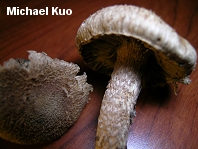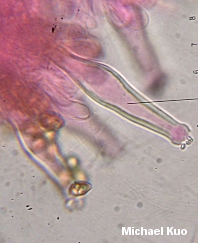| Major Groups > Gilled Mushrooms > Dark-Spored > Inocybe > Inocybe hystrix |

|
Inocybe hystrix [Basidiomycetes > Agaricales > Cortinariaceae > Inocybe . . . ] by Michael Kuo This brown, shaggy Inocybe is a little more easily recognized than many of its brethren. Its cap and stem are both densely covered with scales--a combination not often seen in the genus. I wouldn't go so far as Grund and Stuntz (1980), however, when they write that "[f]ew species of Inocybe are as easy to recognize as this one" (p. 679)--although, as I typed that quote, I realized just how slippery it is, since they don't actually say that Inocybe hystrix is easy to recognize! The long and short of it is that you will need to use your microscope, as always in Inocybe. Phillips (1991, p. 185) points out that Inocybe hystrix and Inocybe lanuginosa, for example, are easily confused in the field. The latter species has nodulose, funky spores that couldn't be more different from the smooth, more or less elliptical spores of Inocybe hystrix--but both mushrooms are brown and scaly, and there are other look-alikes, as well, including Pholiota terrestris. Description: Ecology: Mycorrhizal with hardwoods; growing alone, scattered, or gregariously; fall (and winter in California); widely distributed in North America. Cap: 1.5-4 cm; convex or very broadly bell-shaped; dry; densely covered with brown to dark brown scales that become more and more separated as the mushroom matures, exposing a paler surface beneath the scales. Gills: Attached to the stem; close; white or pale yellowish at first, becoming yellowish brown or grayish brown with maturity (and then usually with whitish edges); at first sparsely covered by an ephemeral cortina. Stem: 3-8 cm long; up to nearly 1 cm thick; more or less equal; dry; densely covered with scales like those on the cap; at first, before the scales have separated, appearing sheathed--then, as the scales begin to separate, nearly reticulate, and eventually with clearly separated brownish scales over a pale background; sometimes with a ring zone resulting from the cortina. Flesh: Whitish. Odor: Mild or spermatic. Chemical Reactions: KOH on cap instantly purplish gray. Spore Print: Brown. Microscopic Features: Spores 9-13 x 5-6.5 µ; amygdaliform to more or less elliptical; smooth. Pleurocystidia 50-90 x 12-22 µ; broadly ventricose with a capitate or subcapitate apex; walls 2-2.5 µ thick. Cheilocystidia and/or sterile cells on lamellar edge present; variable. REFERENCES: (Fries, 1838) Karsten, 1879. (Kauffman, 1918; Kauffman, 1924; Grund & Stuntz, 1980; Phillips, 1991/2005; Hansen & Knudsen, 1992; Phillips, 2005; Miller & Miller, 2006.) Herb. Kuo 01120502. This website contains no information about the edibility or toxicity of mushrooms. |
© MushroomExpert.Com |
|
Cite this page as: Kuo, M. (2005, February). Inocybe hystrix. Retrieved from the MushroomExpert.Com Web site: http://www.mushroomexpert.com/inocybe_hystrix.html |

